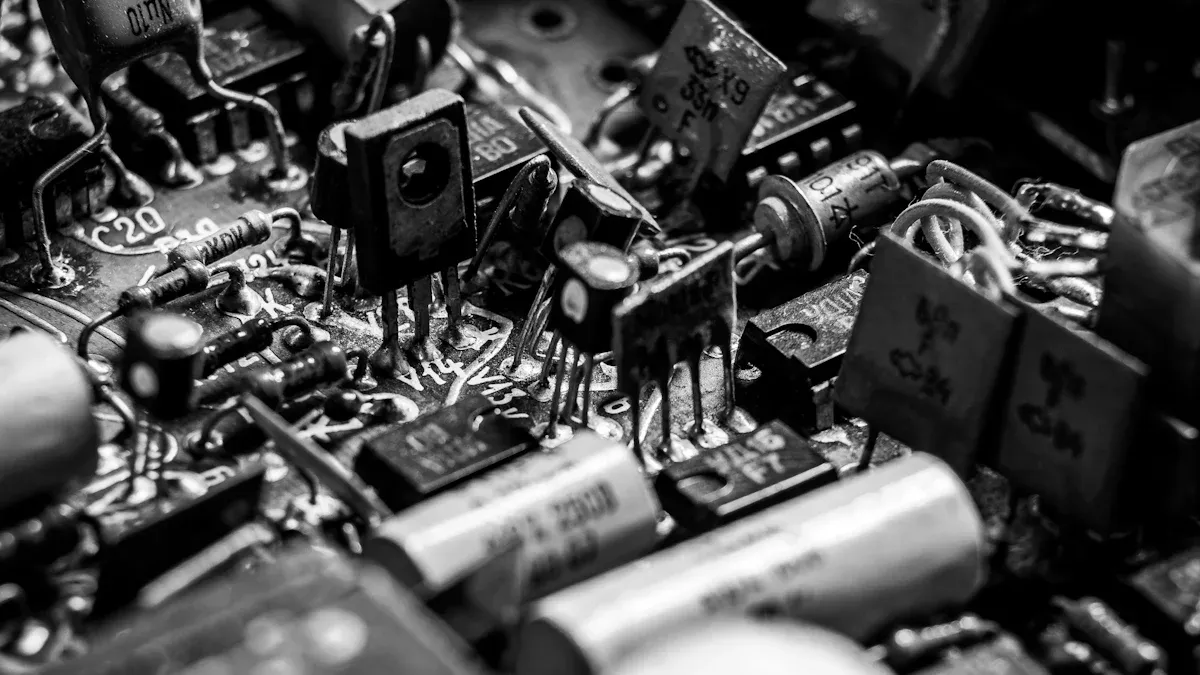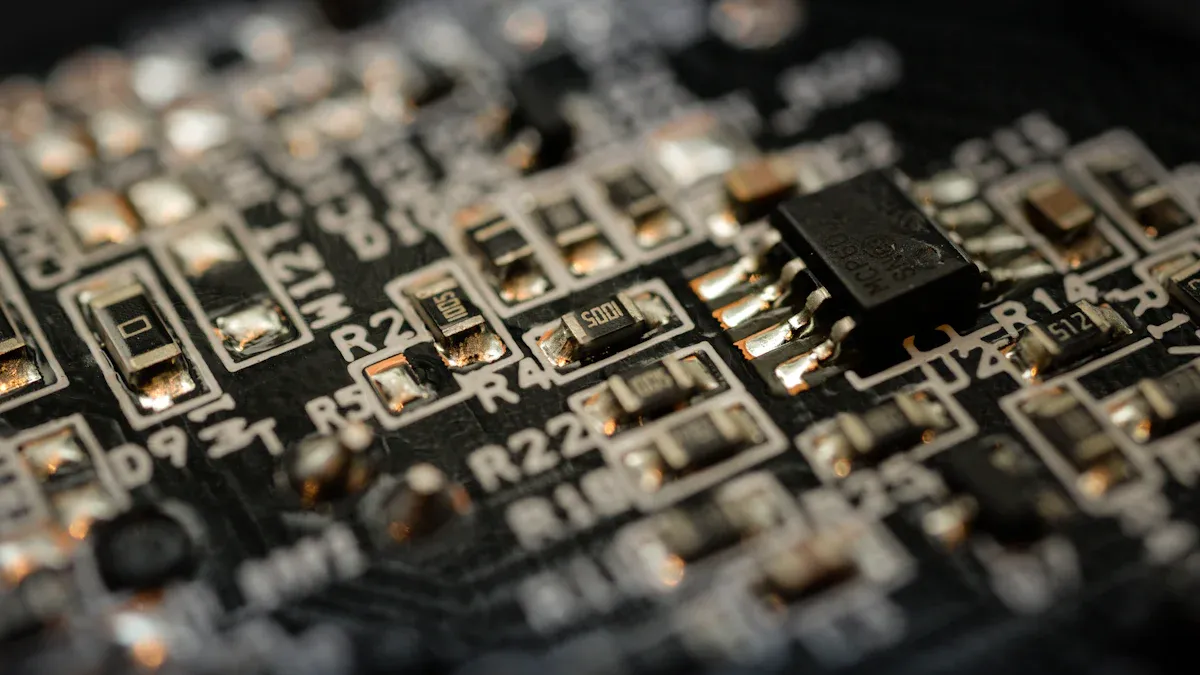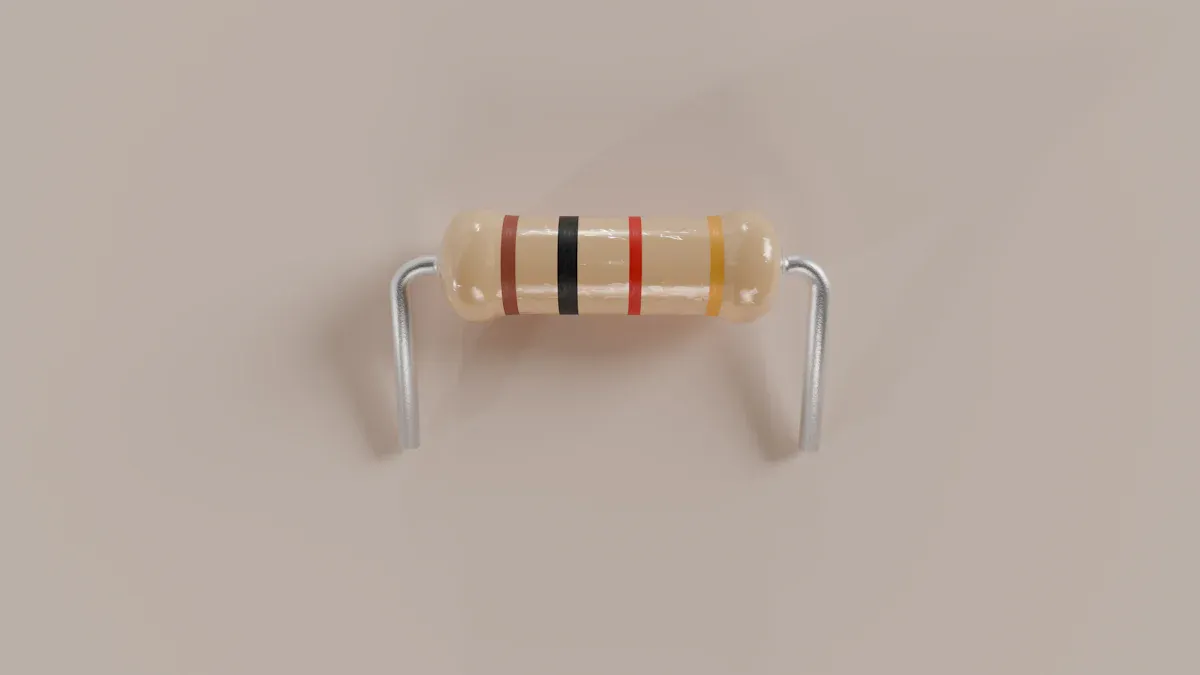
A resistor block helps you manage the flow of electricity in a circuit. You can think of it as a group of resistors combined into one unit. The main resistor block function includes controlling current, dividing voltage, and protecting sensitive parts from too much power. When you understand how these blocks work, you can build safer and more reliable electronic devices.
Key Takeaways
-
Resistor blocks control the flow of electricity by limiting current and dividing voltage to keep circuits safe and stable.
-
They protect sensitive parts like LEDs and microchips from damage by ensuring the right amount of power reaches each component.
-
Resistor blocks combine multiple resistors in one unit, saving space and making circuit assembly easier and more reliable.
-
Choosing the right resistor block means checking resistance, power rating, and tolerance to match your circuit’s needs and avoid overheating.
-
Using resistor blocks in your designs improves safety, reliability, and performance across many devices, from consumer electronics to cars.
Resistor Block Function
Current Limiting
You use a resistor block to control how much current flows through your circuit. This is one of the most important resistor block function roles. When you add a resistor block, you set a limit on the maximum current that can pass. This helps prevent wires and components from overheating or getting damaged.
For example, engineers tested a current limiting strategy using simulations and real experiments. They connected a resistor block in series with a rectifier to limit current during a fault in a power system. The results showed that the resistor block function worked well, even when the system had both positive and negative power flows. You can see that using a resistor block helps keep your circuit safe during unexpected events.
Tip: Always check the current rating of your resistor block before adding it to your circuit. This helps you avoid accidental damage.
Voltage Division
Another key resistor block function is dividing voltage across different parts of your circuit. When you connect resistors in series, each one gets a share of the total voltage. The amount each resistor receives depends on its resistance value. This lets you create specific voltage levels for different components.
Here is a table that shows how resistor blocks behave in different circuit setups:
| Circuit Configuration | Resistor Behavior in Voltage Division |
|---|---|
| Series | Limits current; voltage drops proportionally to resistance, enabling voltage division across resistors in series |
| Parallel | Same voltage across each resistor; current divides inversely proportional to resistance, affecting voltage distribution indirectly |
You can use the voltage divider formula to calculate the voltage across each resistor. For example, if you have two resistors in series, the voltage across the second resistor equals its resistance divided by the total resistance, multiplied by the total voltage. This resistor block function helps you power sensors, LEDs, or other devices that need a certain voltage.
Protection of Components
You rely on the resistor block function to protect sensitive parts in your circuit. Many electronic components, like LEDs or microchips, can only handle a small amount of current or voltage. If you send too much power through them, they can break or stop working.
By adding a resistor block, you make sure that each part of your circuit only gets the amount of current or voltage it can handle. This keeps your devices running smoothly and extends their lifespan. You also reduce the risk of short circuits or fires, which makes your projects safer.
Note: Using a resistor block is a simple way to add an extra layer of safety to your electronic designs.
How Resistor Blocks Work

Resistance and Current Flow
When you add a resistor block to your circuit, you control how much current can move through the wires. Each resistor inside the block offers resistance, which means it pushes back against the flow of electricity. You can think of resistance like a narrow hallway that slows down a crowd. The higher the resistance, the less current gets through.
Ohm's law helps you understand this relationship. The law says that voltage equals current times resistance (V = IR). If you know two of these values, you can always find the third. For example, if you increase the resistance in your circuit, the current will go down as long as the voltage stays the same. This is a key part of how the resistor block function keeps your circuit safe.
Many students use simulations to see how current and resistance work together. These tools let you change the resistance and watch what happens to the current. You might notice that some people think resistors "use up" current, but that is not true. Resistors only slow down the flow; they do not consume the current. With the right guidance, you can use these simulations to build a strong understanding of how resistor blocks shape current flow.
Tip: Always double-check your resistor values before building a circuit. This helps you avoid mistakes and keeps your components safe.
Passive Circuit Role
A resistor block acts as a passive component in your circuit. This means it does not add energy or amplify signals. Instead, it simply resists the flow of current and helps set the right conditions for other parts to work well. You do not need to power a resistor block for it to do its job.
You often use resistor blocks to create stable and predictable circuits. For example, you might use one to set the brightness of an LED or to divide voltage between two sensors. Because resistor blocks do not have moving parts or require extra energy, they make your designs more reliable.
Here is a quick list of what makes resistor blocks passive:
-
They do not generate energy.
-
They only resist current.
-
They help control voltage and current levels.
When you understand the passive role of a resistor block, you can design circuits that are both safe and efficient. This knowledge helps you get the most out of every resistor block function in your projects.
Applications

Consumer Electronics
You find resistor blocks in many everyday devices. They help keep your gadgets running smoothly by making sure each part gets the right amount of current and voltage. Here are some ways resistor blocks work in consumer electronics:
-
They regulate voltage and current to prevent damage to sensitive parts.
-
They control gain and bias in amplifiers, which helps you get clear sound from speakers or headphones.
-
They stabilize feedback networks in operational amplifiers, making sure signals stay steady.
-
They condition signals, so your devices can process information correctly.
-
They measure current accurately in current sensing circuits by creating a small voltage drop.
-
They help with temperature compensation, using special resistors that adjust as the device heats up or cools down.
Note: In many home electronics, resistor blocks keep your devices safe even when the temperature changes or the power supply is not perfect.
Automotive and Industrial Use
You also see resistor blocks in cars and industrial machines. For example, the blower motor resistor block in your car’s air conditioning system lets you adjust the fan speed. It does this by switching between different resistors, which changes how much current reaches the blower motor. This keeps the airflow stable and lets you control the temperature inside your car.
In factories, resistor blocks protect motors and sensors from sudden surges. They act as shunts to measure current or as load resistors to test equipment. By using resistor blocks, you make sure machines run safely and last longer.
Filters and Delay Circuits
You use resistor blocks to build filters and delay circuits. In audio systems, resistor blocks help create low-pass or high-pass filters. These filters let you control which sounds pass through and which get blocked. In timing circuits, resistor blocks work with capacitors to set how long a signal lasts. This helps you design alarms, timers, and other devices that need precise timing.
Tip: When you use resistor blocks in these ways, you protect sensitive components and keep your circuits stable, even when conditions change.
Advantages and Limitations
Benefits
You gain several advantages when you use resistor blocks in your circuits. These components help you design safer and more reliable electronics. Here are some key benefits:
-
Space Saving: You can fit multiple resistors into a single block. This saves space on your circuit board and makes your design look cleaner.
-
Simplified Assembly: You install one component instead of several separate resistors. This reduces the chance of wiring mistakes and speeds up your work.
-
Consistent Performance: Manufacturers build resistor blocks with matched values. You get more accurate and stable results, especially in voltage dividers or sensor circuits.
-
Improved Reliability: Fewer solder joints mean fewer points of failure. Your circuit becomes more robust and lasts longer.
-
Easy Maintenance: You can replace a whole block if it fails, instead of searching for a single bad resistor.
Tip: If you want to keep your project neat and organized, choose resistor blocks for repetitive or grouped resistor needs.
Drawbacks
Resistor blocks also have some limitations you should consider before using them. Understanding these drawbacks helps you avoid problems in your designs.
-
Limited Flexibility: You cannot change individual resistor values inside a block. If you need a different value, you must swap the entire block.
-
Heat Buildup: When you run high currents, resistor blocks can get hot. Too much heat may damage the block or nearby parts.
-
Size Constraints: Some resistor blocks take up more space than single resistors, especially if you need high power ratings.
-
Availability: You might not find the exact resistor block value or configuration you need for special projects.
-
Cost: Resistor blocks sometimes cost more than buying separate resistors, especially for custom values.
Note: Always check the power rating and size of your resistor block before adding it to your circuit. This helps you prevent overheating and ensures a good fit.
Selection Tips
Choosing the Right Value
You need to pick the right resistor block for your project to keep your circuit safe and working well. Start by looking at the resistance value. This value controls how much current flows and how much voltage drops across the resistor block. Make sure the resistance matches your circuit’s needs.
Next, check the power rating. A resistor block with a higher power rating can handle more heat. Larger resistor blocks usually have higher power ratings because they can spread out heat better. If your circuit will run in a hot place, choose a resistor block with a higher rating or add a heat sink.
Here is a quick checklist to help you choose:
-
Resistance Value: Pick the value that gives you the right current or voltage drop.
-
Power Rating: Choose a rating above your circuit’s maximum power to avoid overheating.
-
Tolerance: For precise circuits, use resistor blocks with tight tolerance.
-
Temperature Coefficient: Select a low temperature coefficient for stable performance.
-
Material and Construction: Use ceramic or metal film for better heat handling.
-
Mounting Type: Decide between surface mount or through-hole based on your board layout.
-
Environmental Conditions: Think about temperature, humidity, and vibration.
Tip: Always check the datasheet for the resistor block. It gives you important details about ratings and limits.
Integration in Circuits
You want your resistor block to work well in your circuit. Start by defining your circuit and listing all parts, including the resistor block. Think about how resistor tolerances might affect your results. Use circuit simulation tools, like SPICE, to test your design before building it. Simulate different values within the tolerance range to see how your circuit behaves.
Many engineers run hundreds of simulations to check for problems. They look at the average and worst-case results to make sure the circuit stays safe and reliable. You can also use system-level tools, such as MATLAB, to see how the resistor block affects the whole device.
Common pitfalls include:
-
Using a resistor block with too low a power rating, which can cause overheating.
-
Ignoring temperature changes, which can shift resistance values.
-
Forgetting to match the mounting type to your board.
Note: Careful planning and simulation help you avoid costly mistakes and keep your circuit running smoothly.
You now understand how resistor blocks help you control current, regulate voltage, and protect sensitive parts in your circuits. Studies show that resistor blocks combine several resistors in one package, which gives you precise control and better reliability. You see resistor block function in many fields, from cars to medical devices. When you design your own circuits, you can use resistor blocks to make your projects safer and more efficient.
FAQ
What is the difference between a resistor block and a single resistor?
A resistor block contains several resistors in one package. You use it when you need multiple resistors in a circuit. A single resistor only provides one resistance value.
Can you replace individual resistors inside a resistor block?
You cannot replace individual resistors inside a resistor block. If one resistor fails, you must replace the entire block.
How do you know which resistor block to choose?
Always check your circuit’s voltage, current, and power needs. Pick a resistor block with the right resistance, power rating, and tolerance. Review the datasheet for details.
Where do you usually find resistor blocks in real devices?
You find resistor blocks in TVs, computers, cars, and industrial machines. They help control current, divide voltage, and protect sensitive parts.
Do resistor blocks affect circuit performance?
-
Yes, resistor blocks can improve circuit stability.
-
They help you get consistent results.
-
You must choose the correct values to avoid problems.
Written by Jack from AIChipLink.
AIChipLink, one of the fastest-growing global independent electronic components distributors in the world, offers millions of products from thousands of manufacturers, and many of our in-stock parts is available to ship same day.
We mainly source and distribute integrated circuit (IC) products of brands such as Broadcom, Microchip, Texas Instruments, Infineon, NXP, Analog Devices, Qualcomm, Intel, etc., which are widely used in communication & network, telecom, industrial control, new energy and automotive electronics.
Empowered by AI, Linked to the Future. Get started on AIChipLink.com and submit your RFQ online today!

.png&w=256&q=75)









